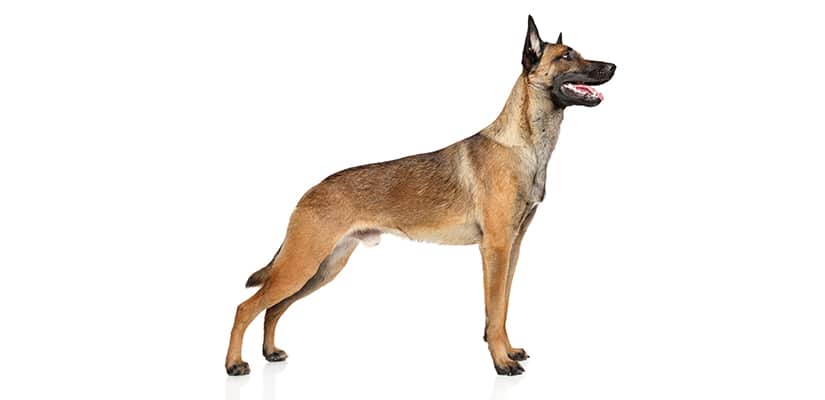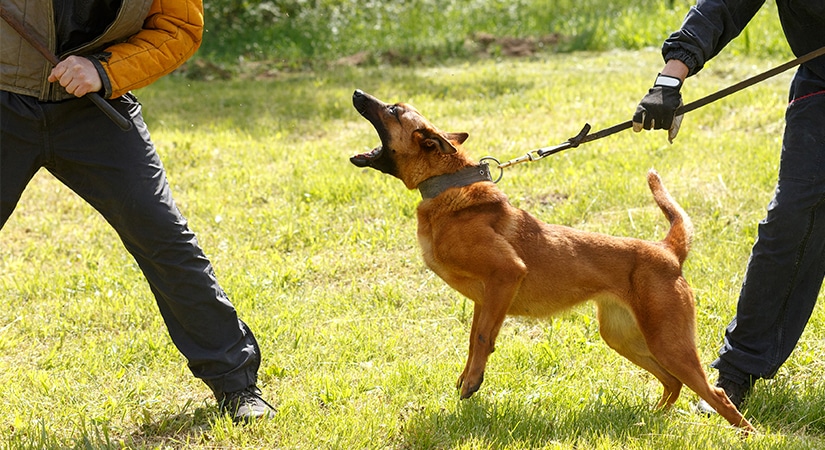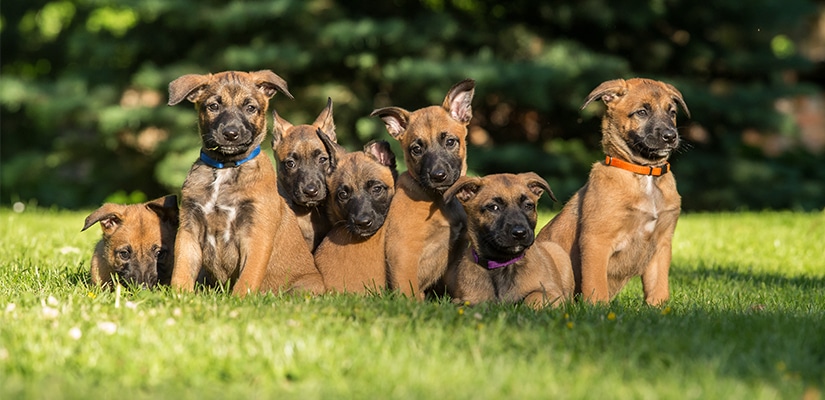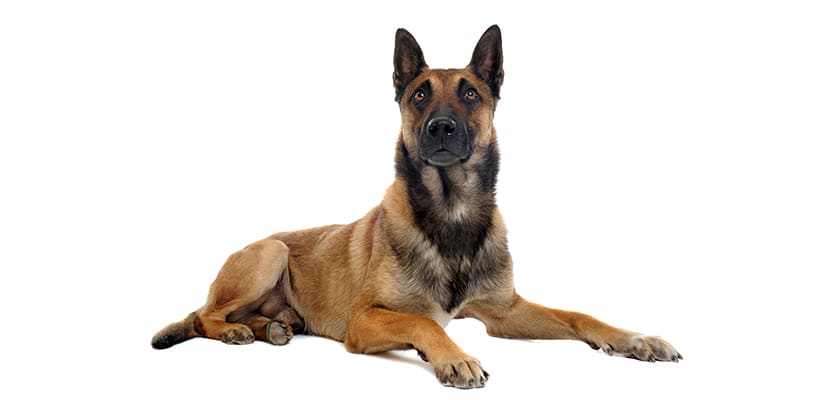The Belgian Malinois, also known as the Belgian Shepherd dog is one breed with four variations throughout the world, apart from in the U.S. In the U.S each variation of the Belgian Malinois is considered a different breed: The Belgian Malinois, the Belgian Tervuren, the Belgian Sheepdog (Groenendael), and the Belgian Laekenois. Belgian Shepherds originated from Belgium during the late 19th century to look after livestock. This breed was also used for police and military work.




Brief History
The Belgian Malinois was first bred in the city of Malines in Belgium. This is one of four breeds that is closely related to the Belgian herding dogs. The Malinois was registered as a separate breed in 1959, and looks very similar to the German Shepherd. This breed is a known for its livestock herding abilities, and were bred by professional breeders wanting a working dog with emphasis on performance. Sheepherders and cattlemen used the Malinois for herding purposes on their farms.
By 1911 the Malinois dog breed was in the U.S. This dog breed suffered during World War 2 when importing dog breeds declined. That said, after WW2, the Malinois languished, and the breed became popular again in the U.S. This breed is exceptional as police and military dogs, and are still sought as cattle herders because of their high work drive.
Physical Description

The Malinois is powerful, lean and muscular. All the while elegant in movement, this well-balanced and squarely built dog breed carries a proud head, held high. With outstanding confirmation, the Malinois has a strong head with a muzzle that is moderately pointed. This breed has dark intelligent brown eyes, and large, triangular prick ears. Malinois are deep –chested, and have different coat colors, coat lengths and coat textures. The Malinois has a short, straight, hard coat that is fawn to mahogany in color. This breed has black tips on their ears and a black mask. The hair is longer on the neck, backs of thighs and tail. Tips of the toes may be white.
The superb Belgian Malinois is an active, intelligent and highly trainable dog breed. This breed has a strong work drive. The Malinois adores their families, and are also protective and territorial. Children need to be supervised around this breed. Because the Malinois is very devoted to family, it does not do well alone all day. This dog breed needs to be around other people, animals, and livestock if possible. The Malinois has to have consistent exercise in the forms of long hikes and off leash runs. This breed needs to begin puppy training classes during puppyhood.
The Malinois can become over- excitable and difficult to train later on. The Malinois needs to have a combination of mental stimulation, human companionship and exercise every day. This breed is so intelligent, that if not exercised enough can display undesirable behavior. Socialization during the first four weeks onward is a priority with this dog breed, so that it gets used to people, other dogs and animals. The Malinois is a one-person dog breed that does well with Schutzhund, herding, obedience training, tracking, and agility. They also make for awesome jogging and biking partners.
Special Needs
The Belgian Malinois needs plenty of attention, exercise, positive dog training, and socialization. This dog breed is one of the most intelligent and active working dog breeds. With a need to please, the Belgian Malinois problem solves, and can be feisty during puppyhood if positive training has not been started. This is a dog breed that demands respect, attention and human bonding.
The Malinois is sensitive to other people’s moods. That said, the Malinois is a smart and confident dog breed, and also independent. The ideal home environment for the Malinois is with expert dog parents that enjoy going to canine sporting events, and having fun with their dogs.
This breed is ideal to have at home on large grounds with plenty of space. They make for wonderful family guard dogs at home, but need consistency throughout their lives. This breed should never be left alone for long hours to guard. They are sensitive, and need to be indoors with their families and take trips to the beach and the local Starbucks. The more socialization and love this breed gets, the more playful and relaxed the dog.
Possible Health Concerns
The Belgian Malinois is a healthy dog breed that may be susceptible to the following health conditions:
- Anesthesia Sensitivity: Belgians may be extremely sensitive to Acepromazine, an anesthetic. Tiny doses added to anesthetic meds have left some Belgians unable to stand for 24 hours after surgery. Some Belgians may also require IV fluids to recover fully after being given Acepromazine. Deaths have been reported after the use of Rompun in this dog breed.
- Stomach Cancer: Belgian Shepherds may be prone to stomach cancer. Symptoms are similar to those of chronic gastritis. Canine breed disposition has been suspected, although no confirmed studies have as of yet confirmed it.
- Hip Dysplasia: This is a hereditary developmental disease. HD affects Malinois. HD occurs when the hip joint fails to develop properly. In the Malinois with HD, the head of the thigh bone does not fall into the hip socket. The imperfect fit results in the joint becoming loose and unstable, and results in osteoarthritis.
- Progressive Retinal Atrophy (PRA) is the name for a group of diseases that cause degeneration of the retina. This will include inherited abnormalities of the light-sensitive cells.
Exercise

The Malinois is an energetic dog breed that does well with plenty of regular exercise and canine sporting activities. Keep your Malinois mentally stimulated when out exercising for mental well- being. The Malinois was bred to run and herd cattle, so plenty of off-leash exercise is vital to his well-being. You cannot leave the Malinois out in your backyard alone all day. This breed needs consistent exercise, and thrives on being with his pet parent. The Malinois is a one-person dog breed that does well with Schutzhund, herding, obedience training, tracking, and agility. They also make for awesome jogging and biking partners.
Puppy Malinois under 6 months of age need to have special exercise programs especially tailored for puppyhood, so as to prevent hip dysplasia and other injuries related to sports and exercise. Consult with your veterinarian as to the best canine sporting activities for your Malinois.
Nutrition
Feed your Malinois the best high-quality dog food that you can afford. Here’s what to keep in mind:
- Feed a diet from a well-known, reputable company. Contact them with any questions of concern.
- The labels on any diet should meet the levels established by the AAFCO Control Officials and/or feeding trials.
- All dog food diets should have the following statement “Animal Feeding tests using the AAFCO procedures substantiate that “Brand X” provides completed and balanced nutrition for growth (or maintenance.)
- Feed puppy’s puppy food and be sure to feed a large breed like the Malinois puppy, a large breed puppy diet.
- Feeding a small dog diet can cause large dogs like the Malinois to grow too quickly, and can lead to serious growth abnormalities and “growing pains.”
- There is no “best diet”- dogs are individuals. A diet that works for one Malinois may not be the best for another. Age, energy level and individual medical concerns play a large role for each patient.
- The recommended guidelines on bags often contain more calories than some Malinois need. Check with your veterinarian for the best nutritional advice.
- Feed a complete and balanced food for the appropriate life stage of your Malinois.
Malinois pet parents need to understand that the life stage that a dog food is marketed for, may not be the same life stage for which the food actually meets the minimum requirements. Consult with your veterinarian if you need advice about which dog food to feed your Malinois.
Grooming
The Malinois has a short waterproof coat that is wonderfully easy to groom with a medium bristle brush. Rubber grooming mitts also make grooming more thorough by removing dead hair. Shedding in the Malinois occurs twice a year, and extra grooming will be needed then with a slicker brush to remove loose hair.
The Malinois needs regular baths, and rather enjoys having his teeth done daily. Twice yearly visits to the veterinarian for dental hygiene maintenance is required. Ears need to be regularly wiped out, and nails trimmed regularly to prevent pain when walking and running.
Adopting a Belgian Malinois

The Belgian Malinois is such a terrific dog and best friend to have around the home. This breed is best suited for expert dog parents that don’t mind tackling the occasional behavioral problems that may pop up with the excitable adolescent Malinois.
The Malinois can be stubborn, and will playfully challenge pet parents. Because this breed is very energetic, intelligent and playful, the Malinois may be a handful for new dog parents. That said, if the Malinois is not socialized and positively trained early on during puppyhood, there may be aggression and behavioral issues that will need to be worked through with a behaviorist after adoption.
This breed makes for a wonderful adoption. Not only is the Malinois a good family dog that is sensitive to every family member, but a loyal friend. Active family life is necessary with frequent long hikes, trips in the car, and long off-leash runs to tire the Malinois. As with all dog breeds, the Malinois should never be left alone for long periods of time.
When adopting a Malinois, it’s important to spend time with this breed to find out more about any unique quirks. Some Malinois may be more energetic than others. This breed does best with expert pet parents that have an active lifestyle, and a large backyard or farm. As with any dog adoption, make sure that you have the time and resources to take good care of your Malinois. This is such a wonderful breed to adopt, but will need plenty of one-on-one time.
